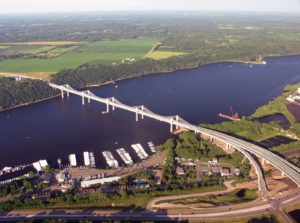
The St. Croix Crossing received a Bridge Design Award of Excellence from the Portland Cement Association. The award is based on five criteria: structural design, function, aesthetics, sustainability and economics. Michelle Wilson, PCA’s Director of Concrete Technology, presented the award at the University of Minnesota Concrete Conference in December 2018.
The bridge, which links Minnesota and Wisconsin, is near the historic town of Stillwater. It is also in an environmentally sensitive area. Bald eagles, Higgins eye pearly mussels, and dotted blazing star flowers received special attention in its construction.
The cement industry has improved the sustainability of portland cement manufacture, mainly by reducing energy consumption. Even so, producing a ton of portland cement clinker releases 0.9 ton of carbon dioxide (CO2) into the atmosphere. Portland cement requires energy to extract the raw materials, crush and pyroprocess them to make clinker, and grind the clinker to make cement. But only part of the carbon footprint comes from burning fuel. The rest comes from the breakdown of the limestone (CaCO3) in the cement kiln.
Achieving both performance and sustainability
Obtaining the desired properties of fresh- and hardened concrete by conventional means often requires large amounts of portland cement. Supplementary cementitious materials (SCMs) can greatly enhance the performance of concrete while reducing its embodied energy and carbon footprint.
The most commonly used SCMs are slag cement and fly ash. Molten slag is tapped off from iron blast furnaces, quenched, and finely ground to make slag cement. Although grinding is energy-intensive, it is less so than pyroprocessing.
Fly ash is a byproduct of generating power from coal. The ash that would escape out the stacks of a coal-fired power plant is instead trapped in bag filters. Fly ash normally does not require further processing (or energy input) for use in concrete.
SCMs make for sustainability
Using SCMs improved the sustainability of the St. Croix Crossing in several ways. First of all, they reduced the amount of portland cement in the concrete. In the precast concrete segments for the spans, SCMs replaced 30% of the portland cement. The mass concrete in the drilled shafts, piers, and crossbeams had up to 85% SCMs. Displacing that much portland cement reduces both the embodied energy and the carbon footprint.
The importance of durability
SCMs also contribute to sustainability by making the concrete more durable. The St. Croix Crossing has a design service life of 100 years.
Operational embodied energy is the non-renewable energy used in maintenance, repair, restoration, refurbishment, or replacement of materials. Designing the concrete for durability in a wet, freezing environment results in much lower operational energy because there’s less need for maintenance and repair.
Environmental factors also influenced the structural design of the bridge. The extradose design combining box girders and cable stays permitted a reduction in the number of piers in the St. Croix River. It also allowed for relatively short towers. Fewer piers made for less disturbance of habitat. Fewer piers and shorter towers meant using less concrete, reinforcing steel, and cable to build the structure.
